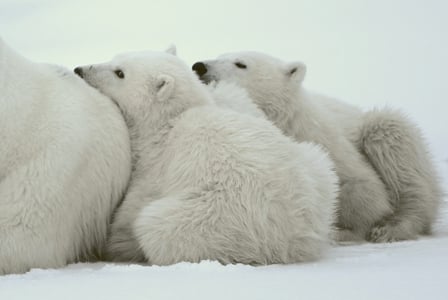
Theyre cute, fluffy, and about as big as a horse. On this Wildlife Wednesday, were learning about polar bears!
On this Wildlife Wednesday, we’re making ourselves feel better about the bitter winter weather by talking about an animal that regularly deals with -40 F (-40 C) winters—the polar bear!
Habitat:
Their name says it all—polar bears live amongst the North Pole’s ice drifts, coastal regions, and scattered islands.
Trivia:
- These furry white wonders claim the title of “world’s largest land carnivore.” Males can reach weights of up to 1,600 pounds (720 kg)!
- Have you were wondered why you don’t see more footage of polar bears falling on ice? That’s because their paws have bumps on them that act like little suction cups, keeping them upright and sturdy.
- Speaking of paws, the paws of adult polar bears are about 12 inches (30 cm) in diameter. Their size makes them great built-in snow shoes that help the bears cross deep snow drifts.
- Usain Bolt doesn’t have anything on these roly-poly wanderers. Polar bears can reach top speeds of about 40 kilometres per hour, making them about two kilometres per hour quicker than the fastest man alive.
Why are they threatened?
Because polar bears rely so much on sea ice, climate change has been having a dramatic effect on their environment. Disappearing sea ice equates to fewer hunting opportunities and longer fasting periods for these bears, as they depend on the ice to hunt for prey.
Oil and gas development also play a role in disturbing the bear’s arctic home. Beyond exposing the bears and their prey to oil spills, the construction of wells and transportation of oil can cause major habitat degradation.
Pollutants are another major threat. As top predators, polar bears are exposed to high levels of harmful chemicals—such as polychlorinated biphenyls (PCBs)—through their prey, causing low levels of vitamin A, and of certain hormones and antibodies.
How can I help?
One thing we can do to help keep these bears afloat is to reduce our carbon emissions. Doing so can be as easy as walking the kids to and from school, biking to the grocery store, and carpooling to work.
Another easy to do so is to make like a polar bear and embrace winter! To celebrate International Polar Bear Day on February 27, Polar Bear International is inviting everyone to take part in the Thermostat Challenge, so pull on a sweater and turn down the heat by two degrees!



